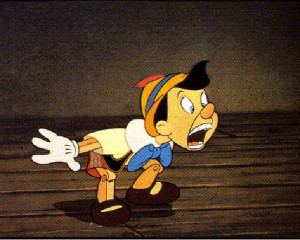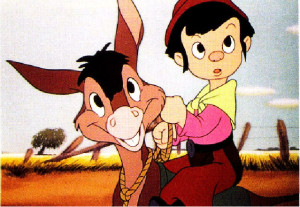Jim on Film
Page 3 of 7

Pinocchio
(c) Disney
Because of this strong emphasis on visuals rather than words, there is a heavy reliance on mute characters in these early films as well, something that isn’t apparent in films from any of the other periods. And, as is characteristic of the time, while there is a strong use of mute characters, there is no repetition of mute personalities.
For example, in Snow White and the Seven Dwarfs and Pinocchio, there are two mute characters who think and respond in a similar manner-Dopey and Gideon. Both perform bizarre actions to get something accomplished. The way Dopey stalks the soap is similar to Gideon writing off the end of his notepad-both are unaware of the oddity to their actions and do so with a slight bent toward mindlessness.
But while these characters share some similarities in acting, they are both very different in personality. For the most part, when Dopey is being goofy, he is aware of it-we are laughing with him. Gideon, on the other hand, is stupid, often bearing his stupidity in his expressions. Gideon is also very sinister, while Dopey is very lovable. These two characters are very different, though it would have been very easy to use the same personalities.
Dumbo is, of course, mute, but he communicates his ideas in very different ways, usually through his eyes and posture. This is unlike Dopey and Gideon who pantomime using their whole bodies. In addition to these, there’s also the plethora of silent characters in Fantasia who clearly communicate ideas without words, as well as the silent creatures and those of few words in Bambi. Because so much time was used to develop these films and the level of creativity at the studio was so high, I think it allowed the artists to experiment and to push their talents in new directions.
Each film from this time also has some very dark moments. The witch’s transformation and her quest for blood; Stromboli and Pleasure Island; the Chernobog; the cruelty toward Dumbo’s mother; and the death of Bambi’s mother, the pack of hunting dogs, and the fire in Bambi. Most interesting, however, is the use of those dark moments in Bambi. Because the film is looking at life in the forest, it never dwells on sadness because to survive, the animals can’t dwell on sadness. When the Great Prince tells Bambi that his mother cannot be with him anymore, they walk into the distance. But the image quickly fades, and it is then spring. Because of that tone, Bambi is less dark than the others despite some strongly emotional events.
After viewing these films together, it was very apparent why this era is called the Golden Age. The films are all perfect. Sure, someone might want to change something for personal taste, but I would challenge anyone to suggest a change that would actually make any of the films better. They are lush with detail, blooming with imagination and creativity, full of life, and all are exceptionally unique.

The Three Caballeros
(c) Disney
The Lean Years (1943-1949)
In several ways, Saludos Amigos fits perfectly in the sequence of films
up to this point in that it is very different from the films preceding it.
Whereas the first five films are lush and dramatic, Saludos Amigos is
educational and comedic. And while it is the shortest of the Disney animated
features, it is the right length for what it sets out to do. The film, unlike
The Three Caballeros, has no narrative structure, so it could not sustain
another ten minutes without seeming like a rambling travelogue. As it is now,
Saludos Amigos is just the right mixture of elements, and it’s not difficult
to see why Saludos Amigos was popular when it was released.
From the years when I was studying these films without having the benefit of being able to see them, I naturally categorized Saludos Amigos with The Three Caballeros; however, upon viewing them in sequence, it became clear that these two films share very little in common. Other than a south-of-the-border flavor and an educational atmosphere in them, they are very different. There is a strong attempt in The Three Caballeros to hold the audience’s attention for an extended period. And it generally works. The final section of the film is really just a series of psychedelic images that bursts into a finale, but up until that point, the creators always throw into the mix something new so that the audience is never sitting around waiting for something to happen. Just as Joe Carioca is done reminiscing about Baia, he asks Donald if he’s ever been there, propelling forward the next series of actions. This constant state of audience interest is particularly impressive considering there is very little plot to the film.
